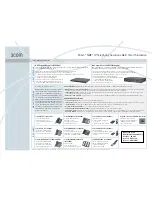
Section 400-Programming
FF3: Extension Programming
576-13-400
DBS 576 (USA) issued 05/20/98
●
Page 3-33
FF1
System
FF2
Trunks
FF3
Extensions
FF4
FF-/Soft Keys
FF5
Groups
FF6
TRS/ARS
0
System
Configuration
FF7
Applications
FF8
Maintenance
Introduction
Appendix A
Appendix B
FF1
System
FF2
Trunks
FF3
Extensions
FF4
FF-/Soft Keys
FF5
Groups
FF6
TRS/ARS
0
System
Configuration
FF7
Applications
FF8
Maintenance
Introduction
Appendix A
Appendix B
❒
Choose Channel Numbering when the information transfer rate is 64 kbps, and the channels on the
span are used as single channels. For example, specify to CO:
1st interface=channels 1-24
2nd interface=channels 25-49
In ISDN, Layers 1, 2 and 3 represent signaling levels over the D-channel. Layer 1 is the basic hardware
level that controls messages regarding electrical characteristics, such as speed, channel structure, etc.
Layer 2 is the “housekeeping” level, containing controls that make sure the messages coincide,
providing sequence and flow control, etc. Layer 3 is the feature level with messages that establish,
maintain, and terminate connections, as well as additional information for different applications, such as
passing the identity of the calling party, passing terminal compatibility information, allowing the
redirection of calls, etc.
Related Programming:
B-Channel Numbering (Layer 3) (pg. 2-71) on ISDN trunks FF2 1 BSSC 03 10 Hold (0 or 1) Hold
Notes:
“1 byte/octet” rotates from 1 to 127 IDs. “2 bytes/octets” rotates from 1 to 32,767 IDs.
Related Programming:
Call ID Length
(all CPCs) - Version 1.0 or higher
Set the ID method by which the system/PBX flags messages sent to the ISDN
PRI equipment for calls.
FF3 1 BSSC 03 02 Hold (0 or 1) Hold
0=1 byte/octet (default for BRI)
1=2 bytes/octets (default for PRI)
BSSC: Extension Port position
B=Cabinet no. 1-6
SS=Slot no. 01-12
C=Circuit no. 1-4 (BRI)
or 1 (PRI)
$
,, 59
















































